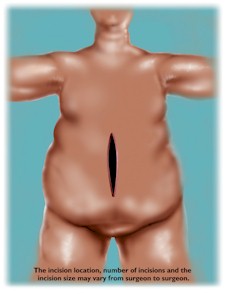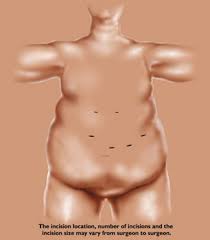Mini Bypass
INTRODUCTION
Roux-en-y Gastric Bypass Surgery offers a successful combination of weight control with minimal nutritional or other risk, when follow up and nutritional guidelines are followed. Many obesity experts consider the surgery to be the "Gold Standard" of modern obesity surgery the benchmark to which other bariatric operations are compared.
The operation restricts food intake and reduces the feeling of hunger. The result is an early sense of "fullness" followed by a sense of satisfaction. Even though the portion size is small (2 to 6 ounces per serving), there is no hunger and no sense of being deprived. Patients continue to enjoy eating all types of food after surgery. They just eat a much smaller portion than they used to.
The Roux-en-y Gastric Bypass is an excellent tool for achieving long-term control of morbid obesity. Excessive Weight loss of 70 - 80 % is achievable by most patients, as internal and external outcome studies demonstrate. And maintenance of that weight loss is likely with adherence to a straightforward behaviour regimen. The Roux-en- Y Gastric Bypass Surgery helps you lose weight in three ways ...
- You eat less (Volume restriction) With a separate small stomach pouch, you feel full after eating a small amount of food. This approach is much more effective in restricting food volume than other surgical techniques, such as stomach stapling.
- Your appetite changes (Behaviour modification) The procedure reinforces a change in your eating habits. After the procedure, most patients find that their body will not easily tolerate foods that are high in refined sugars and fats. With this built-in control, called "the dumping syndrome," which produces short-term discomfort and flu-like symptoms, you naturally learn to avoid these foods. (Our Bariatric Treatment Centres nutritionists help you avoid the foods that may cause discomfort and help you choose from a wide variety of foods you can enjoy.) Other surgical procedures don't provide this important benefit of behaviour modification.
- You absorb fewer calories (Malabsorption) Food bypasses part of the small intestine and digestion occurs in the lower part of the small intestine. These two factors reduce the amount of calories your body absorbs from the food you eat. The reduced stomach pouch size, change in eating habits and absorption of fewer calories allow patients to be successful at long-term weight loss, as opposed to short-term weight loss programs or diets that rely on willpower, costly meal replacements, or dietary supplements.
This procedure is completely reversible !
PREPARATION TO THE PROCEDURE
When you are well informed and choose to have a Gastric Bypass then the following investigations have to take place:
- Laboratory / Blood tests
- Ultrasound of your abdomen
- Electrocardiogram with cardiac check-up
- Chest X-ray with pulmonary check-up
- Gastroscopy
- Consultation dietician
In case of regular medication usage one has to inform their surgeon, especially in case of blood thinners (aspirin, anti coagulants, anti-inflammatory drugs, http://www.ncpainmanagement.com/BloodThinners.htm ) as these need to be stopped before surgery.
On the day of surgery you will have to remain sober. If necessary some medication can be taken with a little water.
PROCEDURE
1. Normally food passes first the oesophagus, than the stomach before entering the small bowel
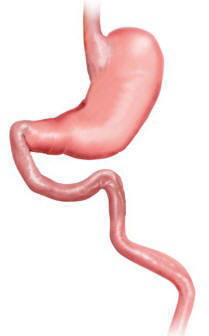
2. Gastric bypass surgery creates a small pouch with a new exit. This is done with the help of a stapler . 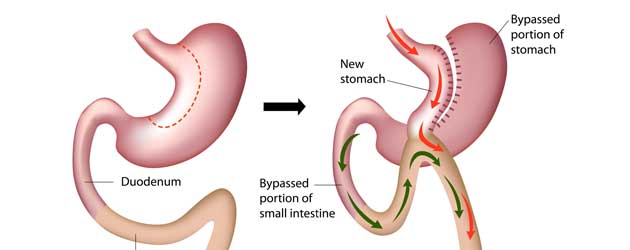
3. The small bowel is than attached to the new stomach. The new smaller exit allows the stomach to empty more slowly.
4. This new connection allows food to bypass part of the small intestine

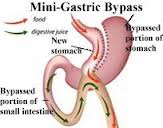
The operation achieves its effects by creating a very small stomach, from which the rest of the stomach is divided and separated. The small intestine is "attached" to the new stomach, allowing the lower pan of the stomach to be bypassed. The Stomach is separated into two parts. The small Stomach pouch receives food. The lower part of the stomach received most of the gastric juices coming from the liver and other organs. The small intestine is carefully measured and cut. One end is connected to the small stomach pouch. The other end is reconnected to the small intestine, forming a "Y".
Food intake will be restricted and you will feel full more quickly than when your stomach was its original size. This reduces the amount of food you eat and thus the calories consumed. Bypassing part of the intestine also results in fewer calories being absorbed. This all leads to weight loss. This procedure is done by laparoscopy.
This procedure is completely reversible !
SURGERY THROUGH LAPAROSCOPY
Weight loss surgery is done by laparoscopy also called minimally invasive surgery or keyhole surgery . It is a modern surgical technique in which operations in the abdomen are performed through small incisions (usually 2-3cm) as compared to larger incisions needed in traditional surgical procedures.
The abdomen is inflated creating sort of ‘air bubble’ as working space. Through 4 or 5 small incisions a camera and small instruments are placed inside your abdomen. The rest of the procedure takes place inside the abdomen.
After the surgery when a patient awakes he or she can experience pain in the shoulders due to the insufflation. Normally this pain disappears within a couple of days.
COMPLICATIONS
1. During surgery or while hospitalized.
As with any surgery, there can be complications. These can occur during surgery, while hospitalized or after discharge. This list can include:
- Bleedings
- Injury to the abdominal organs.
- Stomach ulcers or perforation.
- Deep vein thrombophlebitis with even non-fatal pulmonary embolus
- Gastrointestinal (sub)obstruction
- Urinary infection
- Wound infection
- Pneumonia
- Heart attack
This list is not complete. There is even a very small risk of dying due to complications.
Special measures are taken to minimize the risk of complications. Complications which lengthen the hospitalisation are rare.
2. Complications after being discharged.
a) Gastrointestinal obstruction Due to forming of adhesions which can develop after every kind of abdominal surgery normal passage of bowel can be hindered. Sometimes it s necessary to perform surgery in order to free these adhesions.
b) Forming of Gallstones It is possible to develop gallstones possibly due to less intake of fat.
c) Iron, Folic acid, Vitamin and mineral deficiencies Deficiencies can develop mainly the period when weight is lost. Regularly blood tests are necessary to early detect these deficiencies. Your surgeon will advise you when to take oral supplements.
d) Loss of hair Hair loss occurs with most persons who lose weight quickly. This occurs mainly in the first six months after surgery. This is temporarily and never complete.
e) Stenosis near the exit of the stomach This is very rare and can be solved by gastroscopic dilating.
f) Gastric Ulcers An ulcer can develop at the exit of the new stomach. This is more often seen with smokers or patients who take anti-inflammatory drugs. Medication can cure these ulcers.
g) Weight gain years after surgery
DIET AFTER GASTRIC BYPASS
1. Adjusting eating behaviour
- Eat at diner table
- Have small meals and take your time, use 3 main meals and a few healthy snacks.
- Stop eating after first sensation of satiety, More bites can lead to vomiting.
- Drink slowly but not during a meal
- Avoid alcohol, drinks containing sugar, sweets, cookies, chocolate.
- Avoid using pure sugar
- Limit use of fat in meals
Adaptation of eating after Gastric Bypass goes in different steps from liquids to mixed to protein rich solid food. The meals are much smaller than normal and food needs to be much softer from texture. In every step it is important to drink enough water.
Step 1:
Liquid meals during first 14 days
Use:
- Low fat milk
- Low fat yoghurt
- Vegetable juices
- Soup (blended) or bouillon
- Protein drinks, etc
Step 2.
Slowly change to mixed foods by adding in the next 14 days.
- mashed potatoes,
- cooked/mixed vegetables
- cooked fish, eggs
If this goes well then mixed meat, toasted bread and other food can be added, using small amounts. (= step 3)


